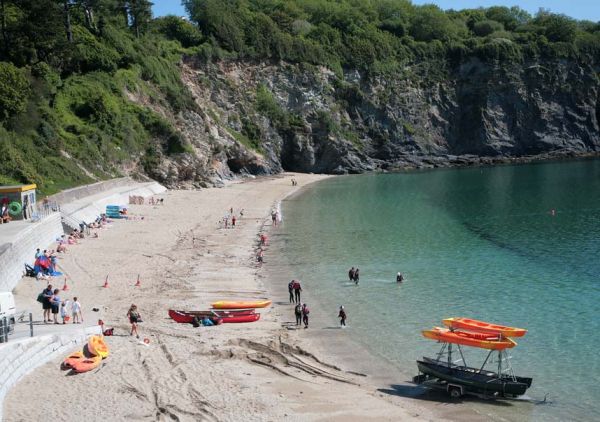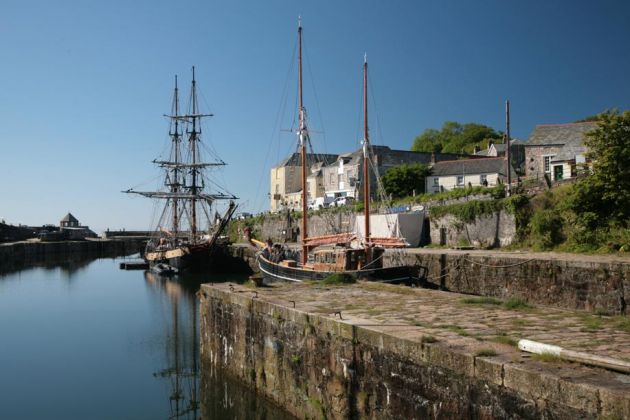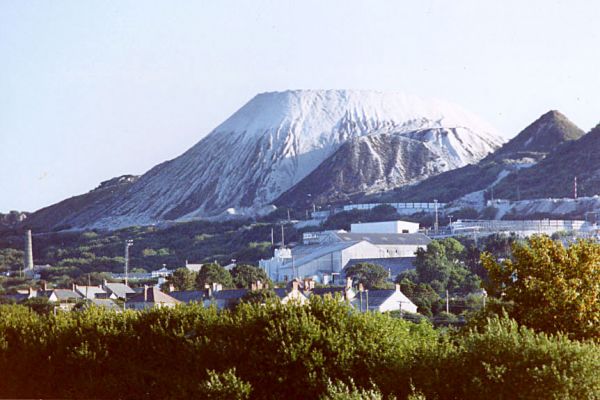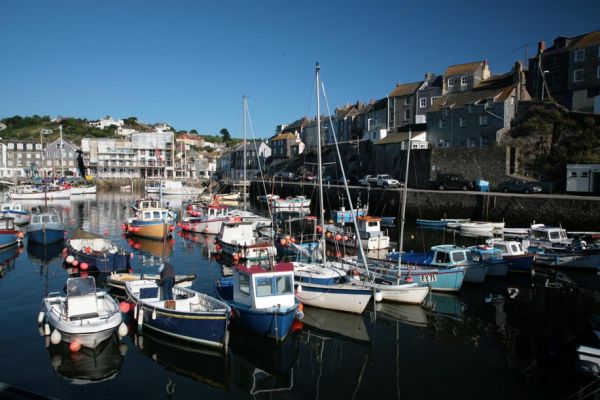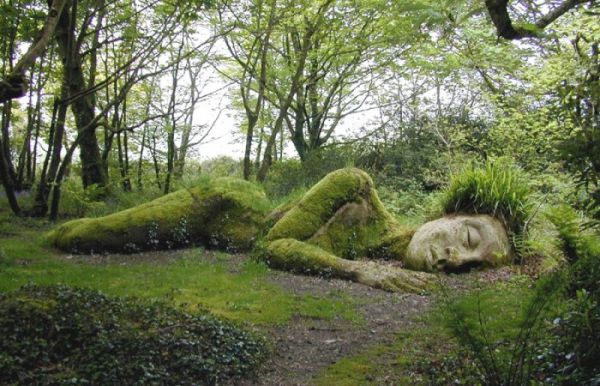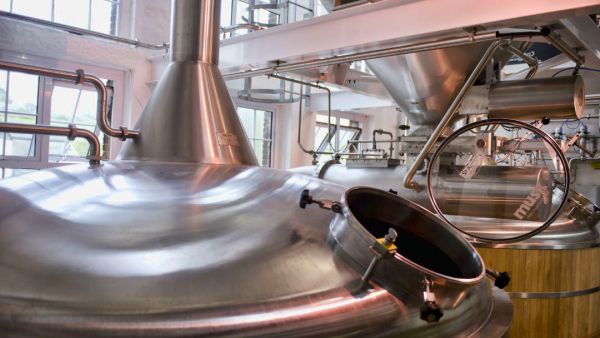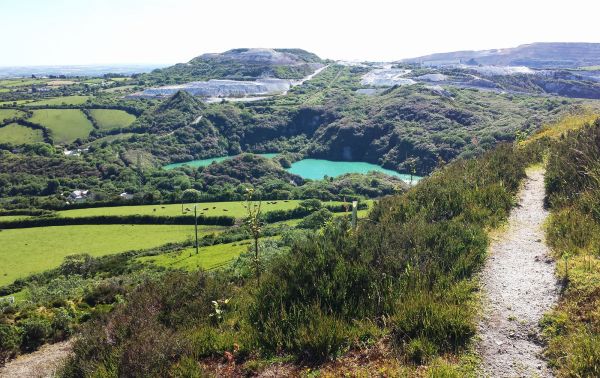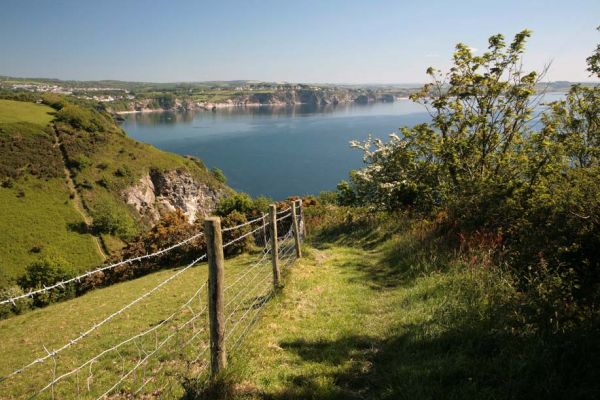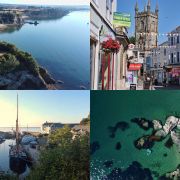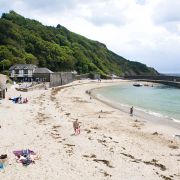I have to be honest, St Austell town isn't my favourite place in Cornwall. I'm guessing I'm not alone in this as I have heard the town referred to jokingly as "Saint Awful". OK, maybe that is a little harsh, but I do struggle to think of a good reason why I would head into Saint Austell for fun.
Now, with that in mind I do have to say that the surrounding area more than redeems itself and is full of fantastic places to visit. The coast, or "St Austell Riviera", is only minutes away and there are any number of charming little fishing villages and beautiful beaches within a stone's throw. Head inland and not only will find some lovely countryside but the fascinating remnants of the once great china clay industry.
Of course it is impossible to mention this area without mentioning the Eden Project. Besides being one of the UK's top tourist attractions it has done much to revive the fortunes of St Austell. So, while the fortunes of this once important Cornish town have to some extent faded this part of Cornwall is as popular a place to holiday as it ever has been.
The Eden Project
There's not a lot to say about the Eden Project that hasn't been said before. Cornwall's most famous attraction is only a couple of miles outside St Austell and is a must for anybody visiting the area, or Cornwall in general.
The Eden Project centres around the spectacle of its huge futuristic biomes built into the slopes of an old clay pit. But there is also a strong, environmentally-themed message here with the project being run by the Eden Trust, an educational charity.
Of course the main attraction at Eden is the biomes. These are effectively giant greenhouses with the biggest measuring 787 feet (240 m) long and 180 ft (55 m) high. There are two of these, or possibly three, but we'll get to that. The lush Humid Tropics Biome simulates the climate of a tropical rainforest and contains trees and plants from tropical regions of South America, Africa, Asia and Australia. Marginally smaller is the Warm Temperate Biome with its Mediterranean climate. Here you will find plants from Southern Africa, California and Southern Europe, as well as a very pleasant little cafe.
The third biome is the "roofless biome", or outside as we like to call it! As Cornwall has a particularly mild climate many plants not seen in the rest of the UK thrive here. So expect to see selected plants from Chile, the Himalayas, Asia and Australia in the immaculately landscaped gardens around the main biomes.
Beaches of St Austell Bay
St Austell Bay officially stretches from Gribbin Head in the east around to Black Head in the west. However, we'd consider including the beaches up to Dodman Point, a little further south. Between these two headlands is a coastline fringed with white sand beaches.
There are too many first class beaches along this stretch to name each and every one of them and they come in a range of shapes and sizes, all with their own individual character. The closest beaches to St Austell are Carlyon Bay, Duporth, Charlestown and Porthpean. Of these Porthpean is my favourite (which is why it is featured in the photo above). With its calm, clear water and backdrop of lush, green cliffs it has something of the feel of a Mediterranean beach. It is also great for a whole host of watersports - but not surfing, which none of the beaches on this stretch of coast are.
A little further afield and the beaches only get better, and less busy. Vault beach is a particular gem, if you can find it. Whilst in the opposite direction Polkerris is a cosy little sandy beach with a historic harbour and charming village as a backdrop. Basically, there aren't any bad beaches on the Cornish Riviera, just head for the sea and you'll strike gold!
Charlestown
Only a few minutes drive from St Austell, Charlestown is a uniquely preserved example of a late Georgian working port. The village began life as West Polmear, a fishing community of just nine residents and a small pilchard fleet which used the beach as a harbour. At the end of the 18th century local landowner Charles Rashleigh more or less rebuilt the village in response to the growth of the local mining industry, and named it after himself.
Back in those days this was a major industrial hub but more recently the villages charms have not gone unnoticed. The picturesque juxtaposition of roughly-hewn fishermen's cottages and period houses, together with a fleet of tall ships, at least one of which is usually moored in the harbour, have helped to put Charlestown on the map as Cornwall's most popular filming location. It has featured in many major film and television series including Hornblower, Mansfield Park and, perhaps most notably, Poldark.
China Clay Country
Whilst Cornwall's industrial past is most strongly associated with tin mining and fishing there was another industry, and this has possibly left a greater mark on the landscape around St Austell than both of these. Visible from miles around are the sharp peaks of the "Cornish Alps", the white-capped mountains of spoil left over from the once mighty china clay industry. These are the visible remnants of a story which goes back two hundred and fifty years.
Back in the mid-1700s fine china pottery was something of a rarity and had to be imported at considerable expense. The alternative was rather crude earthenware, but the gentry wanted porcelain. Spotting this gap in the market a Plymouth apothecary by the name of William Cookworthy began looking for a home-grown substitute for the authentic Chinese clay. The actual material is kaolin, a fine powder formed from naturally decomposed granite. Cookworthy first found kaolin at Tregonning Hill near Helston, but by the 19th century the biggest deposits in the world had been discovered around St Austell.
The reason the industry has had such an impact on the landscape is quite simple. For every ton of china clay extracted five tons of waste were created. This soon began to add up in the form of the ever rising Cornish Alps and the huge open pits that accompanied them. It is estimated that by the turn of the century approximately 1 million tons of china clay were being produced every year. It doesn't take much imagination to work out that this would result in an awful lot of earth being moved.
The result is the sometimes lunar-like terrain and blue-green lagoons that now dominate parts of the local landscape. Over recent years trees have been planted and some of the peaks have been greened over. Whilst not natural, this scenery is certainly dramatic and is now a firmly iconic part of Cornwall.
Mevagissey
Located about 3 miles south of St Austell, the charming fishing village of Mevagissey is well worth a visit. Once the centre of Cornwall's pilchard fishing industry, the over-sized harbour here is still the focus of activity in the village. Whilst the three-storey harbourside warehouse buildings might now been shops and holiday accommodation this is still a working harbour with a few dozen fishing boats. Many visitors to Mevagissey come for the boat trips; as well as numerous fishing trips there is a daily ferry to Fowey during the summer which takes around 35 minutes.
Perhaps the most popular activity in Mevagissey though is just mooching around the harbour and village. The twin harbour here consists of an inner and outer section with a long pier which makes for a pleasant stroll. Beyond the harbourfront are a maze of narrow streets to explore and where you will also find plenty of pubs, cafes, galleries and shops. If you stay for the evening there are a few good restaurants here including some great seafood options offering locally caught mackerel, lobster and scallops.
Today Mevagissey is well equipped for visitors and there are any number of things to do for all ages. Along with the harbourside museum is a small aquarium and the long-running Mevagissey Model Railway.
Lost Gardens of Heligan
For many years I had Heligan (pronounced 'heh-liggen') as just another Cornish garden to see. Yes, Cornish gardens are great and it was on the todo list but I never go around to it. Then a few years back I had a free family pass and the weather was great so I decided to take a look. I have to say the Lost Gardens no rank up there with my favourite places to go in Cornwall and I can't wait to go back.
In the old days the gardens here were just known as Heligan and where owned by the Tremayne family for over 400 years. Shortly after the turn of the 20th century there were 22 gardeners maintaining the gardens, but tragedy struck in the form of World War I. No less than sixteen of the gardeners were killed in the war and the decline began. Over the next 70 years or so the once beautiful gardens returned to nature, buried under weeds and brambles.
Enter Tim Smit, of Eden Project fame. Upon hearing about Heligan he had the vision of bringing them back to their former wonder and so in 1990 the work began. Today, rebranded as The Lost Gardens of Heligan, the 200 acre site is home to a wonderful array of quirky and characterful gardens featuring old potting sheds, green houses, grottos and walled kitchen gardens. There are more palm trees and ferns here than anywhere else in the UK and any number of unique features such as rope bridges, the "Mud Maid", the Melon Yard and the Pineapple Pit. This is a place with genuine appeal to all ages and is a must-see if you are near St Austell.
St Austell Brewery
If you find yourself in St Austell town, possibly on a rainy afternoon, then a visit to the town's brewery is a great way to kill a couple of hours. Founded in 1851 by Walter Hicks, St Austell Brewery now owns over 150 pubs and several hotels across Devon and Cornwall. It also makes some of Cornwall's most popular beers and sells in excess of 50,000 barrels. This apparently equates to nearly 2 billion pints having been produced since 1851.
The St Austell Brewery sits overlooking the town and has not changed a great deal in the 150 years or so since it was built. To a large extent the brewing process itself is largely unchanged either. The visitor centre tells the fascinating story of Walter Hicks' brewing empire and offers guided tours around the brewery. You will get to see Victorian Brewhouse where much of the beer is still produced, the Cask Racking Plant where the premium ales are barrelled and the Cooper's Workshop which shows how things were done in the old days.
During and after the tour there is plenty of opportunity to test some of St Austell Brewery's finest ales, including a select few from the Small Batch Bar. All tours are rounded off with a complimentary beer in the Hicks Bar, and some of the tours even throw in a pasty too.
The Clay Trails
In order to open up the fascinating and sometimes striking rural scenery inland from St Austell a number of traffic-free trails have been designated. Known as the Clay Trails these allow walkers, cyclists and horse-riders to explore the a countryside shaped by 250 years of the china clay mining industry. Along with the rolling hills and farms are a number of clay tips forming steep-sided, miniature mountains and deep aquamarine lakes often referred to as the "Cornish Alps".
There is no doubt the best way to see this remarkable and historic landscape is from the Clay Trails. Opened in 2005 there are 9 main routes, although there are many smaller interlinking paths and bridleways that criss-cross the area. One of the most accessible and popular of the trails is the Pentewan Trail which follows the route of a long-abandoned narrow-gauge railway from Pentewan harbour to the curiously named village of London Apprentice.
Another of the easier trails is the so-called Green Corridor which runs from Tremena Gardens in St Austell to the China Clay Country Park at Wheal Martyn. This gently sloping route is only a couple of miles long and takes in some of the areas decaying industrial heritage in the form of old clay dries and an impressively tall brick chimney all used in the clay drying process. The other trails take you further into Clay Country but some are significantly more challenging.
If you are planning a days walking the Clay Trails can be combined with each other and even the coast path (below) to create circular routes. This is particularly the case for the Pentewan Trail
Coast Path
Walking the 10 mile stretch of coast path between Mevagissey and Par is a fantastic way to see this section of coast. As well as taking in all the well known beaches of St Austell Bay this walk provides access to any number of secret coves that are not accessible from the road. It also takes you through the beautiful undulating countryside found between St Austell and the Roseland Peninsula.
There are a number of highlights along the route starting with Mevagissey itself. You could spend half a day here, but if you want to complete this walk you'll need to crack on. The first stop is Pentewan with its wide, sandy beach and silted up old harbour - this is wonderfully peaceful spot to take a breather. Next the path climbs up towards Black Head where you will get a commanding view of St Austell Bay. Beyond here is a short wooded stretch including Hallane Mill beach which is home to a waterfall.
Much of the rest of the coast path takes in St Austell's main beaches; Porthpean, Duporth and Carlyon Bay. Between these is the idyllic Georgian harbour of Charlestown, which is a great place to stop off and perhaps grab a bite to eat. The final stretch skirts the golf course at Carlyon before taking on a distinctly industrial feel as it passes through the china clay docks at Par. All that is left from here is the sandy expanse and dunes of Par Sands where you can take a well earned rest on the beach.
Luxulyan Valley
Located within a stone's throw of the Eden Project is the hidden gem of Luxulyan Valley. A two-mile long, picturesque, steep-sided wooded valley through which the Par River cascades. Whilst the natural woodland would be enough to make the valley worth a visit there are also fascinating glimpses into the areas industrial heritage scattered throughout the valley.
Much of the old workings at Luxulyan were the work of Joseph Treffry, a local mine owner. He built a series of leats, tramways and waterwheels to help transport ore from his mines to the port at nearby Par. Now in varying states of decay, and partly reclaimed by nature, these reminders of the valley's industrial heritage add an eerie beauty of their own. Most notable of the old workings is the Carmears Wheel Pit, which once held a mighty water wheel used to generate the power to haul ore trucks up the adjacent hillside.
Of all the structures built by Treffry in Luxulyan Valley is the magnificent ten-arched viaduct which bears his name. Standing over a hundred feet above the valley floor the Treffry viaduct was built to carry both mine trucks and the water used to power the Carmears water wheel.
Beyond Treffry's industrial legacy in the valley this is still a place of natural beauty and home to a range of flora and fauna. There are over 40 species of fern to be seen here and the valley is designated a regionally important geological and geomorphological site (RIGS).

